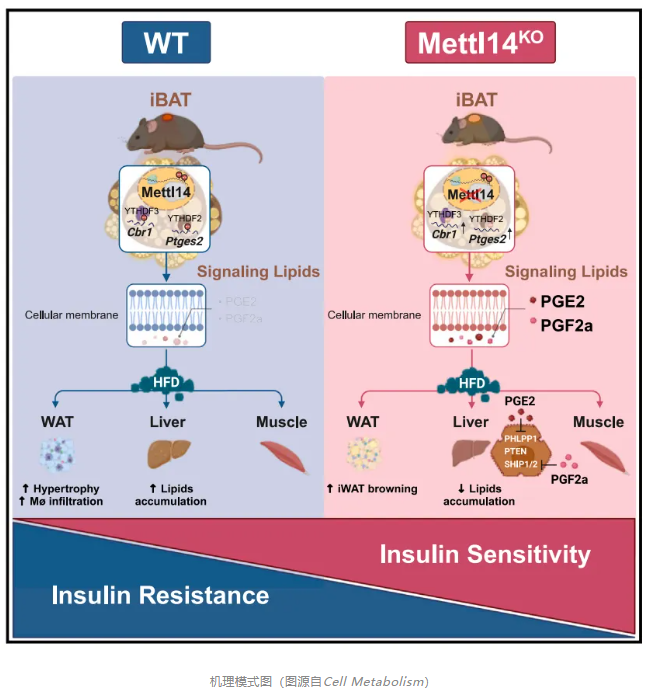11
2024
-
09
He Chuan and other teams have shown that METTL14 regulates insulin sensitivity throughout the body through a mechanism independent of UCP1!
Author:
Brown adipose tissue (BAT) regulates systemic metabolism by releasing signaling lipids. N6-Methyl adenosine (m6A) is the most prevalent and abundant post-transcriptional mRNA modification reported to regulate BAT adipogenesis and energy expenditure.
On September 9, 2024, Rohit N. Kulkarni of Harvard Medical School and He Chuan of the University of Chicago in the United StatesCell Metabolism(IF=27.7)Published online entitled“m in brown fat6A mRNA methylation regulates systemic insulin sensitivity independently of UCP1 via the interorgan prostaglandin signaling axis”The research paper,The study showedm in brown fat6A mRNA methylation regulates systemic insulin sensitivity via an interorgan prostaglandin signaling axis independent of UCP1.
Here, the researchers demonstrate that m6Deletion of A methyltransferase-like 14 (METTL14) alters the BAT secretome to improve systemic insulin sensitivity independent of UCP1.Using lipidomics, prostaglandin E2 (PGE2) and prostaglandin F2a (PGF2a) were identified as insulin sensitizers secreted by BAT. PGE2 and PGF2a inversely correlate with human insulin sensitivity and protect mice from high-fat diet-induced insulin resistance by inhibiting specific AKT phosphatases.Mechanically, METTL14-mediated m6A promotes the decay of genes PTGES2 and CBR1 encoding PGE2 and PGF2a biosynthetic enzymes in brown adipocytes through YTHDF2/3. Consistent, BAT-specific knockdownPtges2orCbr1Reversible M14KOInsulin sensitization in mice.Collectively, these findings reveal a new biological mechanism by which the m6A- dependent regulation of systemic insulin sensitivity.
Notably, BAT has been reported to have a positive effect on systemic metabolism through the secretion of factors including peptides, proteins, lipids or microRNAs.In particular, a class of lipids called "BAT lipid factors" has attracted attention in recent years. The term "lipid factors" was originally defined as lipid hormonal processes secreted by adipose tissue that are involved in systemic metabolism, including the regulation of insulin sensitivity, glucose tolerance and inflammation.For example, 12,13-diHOME, when induced by cold and exercise, enhances fatty acid transport to BAT, reduces circulating triglycerides, and promotes fatty acid uptake by skeletal muscle. 12-HEPE, another cold-induced BAT liptin, stimulates glucose uptake by BAT and muscle.

In this study, the authors propose to modulate systemic insulin sensitivity METTL14 modulating BAT secretion through a unique mechanism independent of UCP1. BAT-specific Mettl14 knockout (M14KO) mice showed improvements in insulin sensitivity and glucose tolerance, independent of body weight, sex, or standard BAT thermogenesis.Non-targeted lipidomic analysis of mouse BAT and human brown adipocytes (hbat) found that METTL14 lacked secondary up-regulation of prostaglandin E2 (PGE2), prostaglandin D2 (PGD2), prostaglandin F2 alpha (PGF2a), and 13,14-dh-15-keto-PGE2.PGE2 and PGF2a improve whole-body insulin sensitivity by inhibiting AKT phosphatase in key peripheral metabolic tissues. Mechanically, the lack of METTL14 in BAT prevents the decay of PTGES2 and CBR1 transcripts that encode prostaglandin biosynthetic enzymes, allowing their protein levels to increase. M14KO-Interscapular BAT (iBAT)Ptges2orCbr1Down-regulation of the gene reverses the insulin-sensitizing phenotype.Taken together, these results demonstrate a new mechanism for the m6AMethylation is coupled to the BAT secretome to modulate systemic insulin sensitivity independent of the typical BAT thermogenic action.
Chongqing Chongfan Technology Co., Ltd. Optical platform film thickness meter OCT optical coherence tomography LabVIEW control
LATEST NEWS
2024-09-16
Tsinghua University Xiao Bailong/Peking University Ouyang Kunfu Collaboration Reveals Key Phosphorylation Sites That Regulate Piezo1 Mechanical Sensitivity and Mechanotransduction Function in Vivo
Piezo1 is a mechanically activated cation channel that can convert mechanical forces into various physiological processes. Due to its large protein size of more than 2500 amino acids and complex 38 transmembrane helix topology, how Piezo1 is post-translationally modified to regulate its mechanotransduction function in vivo remains unexplored.
2024-09-18
Huazhong University of Science and Technology Wang Cong Yi/Sun Fei found in obese environment really pathogenic adipose tissue macrophage subsets
Adipose tissue macrophages (ATMs) play an important role in maintaining adipose tissue homeostasis and coordinating metabolic inflammation. Given the extensive functional heterogeneity and phenotypic plasticity of ATMs, there is a need to identify truly pathogenic subpopulations of ATMs in the context of obesity.
2024-09-14
Wang Su's team at Southeast University found that microenvironmental glial cells regulate stem cell self-renewal and differentiation by delivering iron to neural stem cells through ferritin
The study of neural stem cells is of great significance for the treatment of neural development and nervous system diseases. However, the regulation mechanism of neural stem cells has not been fully elucidated, especially the regulation of neural stem cells by microenvironment is relatively less known.
2024-09-14
Subversion of the past! Tsinghua University Dai Qionghai/Guo Zengcai/Wu Jiamin Cooperation Latest Cell
A comprehensive understanding of physiopathological processes requires non-invasive live three-dimensional (3D) imaging on different spatial and temporal scales. However, huge data throughput, optical non-uniformity, surface irregularities, and phototoxicity pose huge challenges, resulting in inevitable trade-offs between volume size, resolution, speed, sample health, and system complexity.
2024-09-11
The latest research by Guo Jianping/Cheng Chao/Bo Lang of Sun Yat-sen University confirms that palmitic acid can suppress virus infection by activating innate immunity!
Innate immunity is the primary defense against viral and microbial infections. The exact effect of cellular metabolites, particularly fatty acids, on antiviral innate immunity remains largely elusive.

